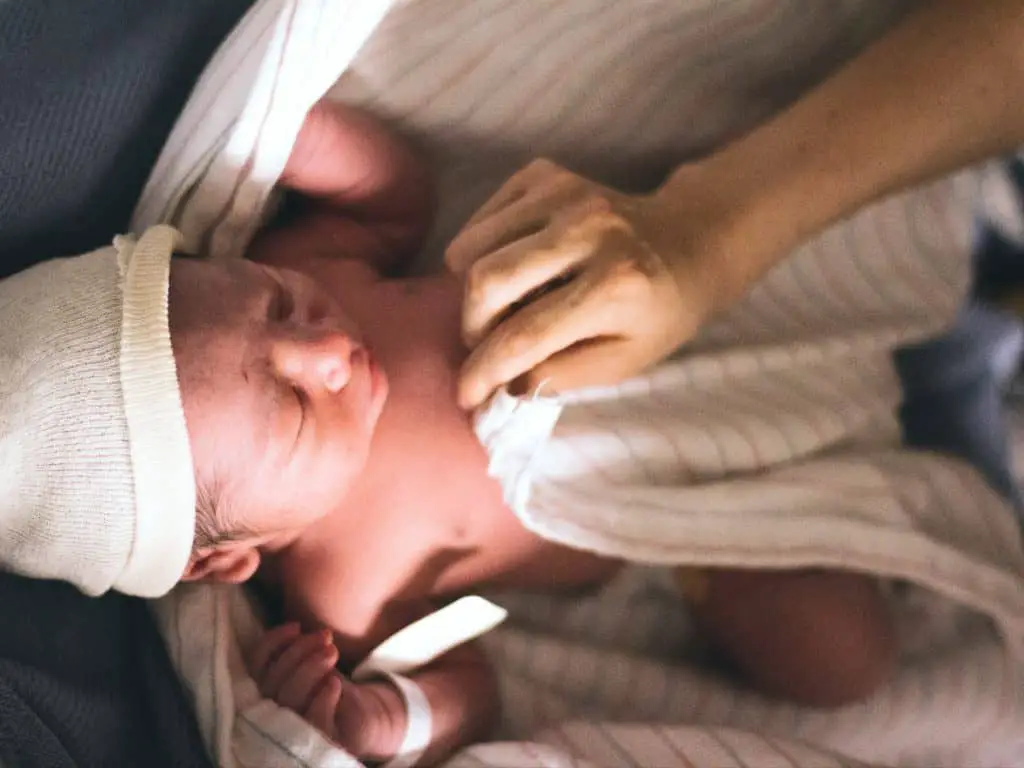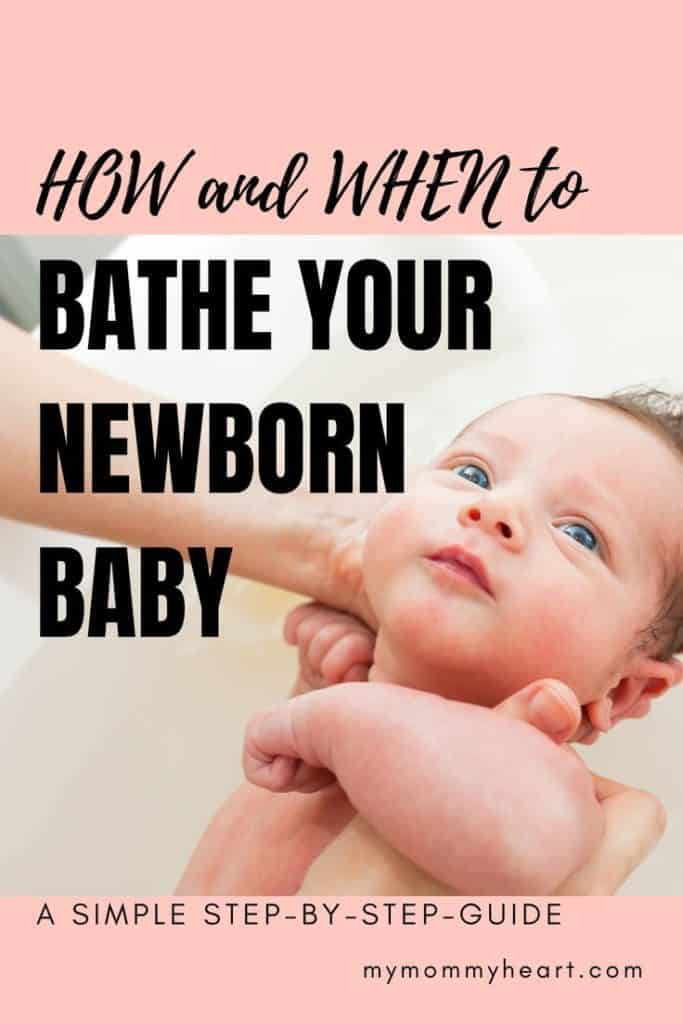If you are a mom-to-be or have just given birth to your baby, you might be wondering about how to bathe a newborn. First of all, get your camera or phone ready to take a few pictures. You will love to have a small memory later on. The first bath time is so special.
Then gather all the baby bathing essentials and prepare the warm water. When you are ready, you can start bathing your newborn.
This step-by-step guide will lead you through it and provide a safe experience for mom and baby.

When to bathe a newborn for the first time?
The first bath for your baby should be a gentle sponge bath within the first few days after birth. Due to the risk of infection, you should wait with a tub bath until the umbilical cord stump falls off. Then, 10-14 days after birth, you can bathe your newborn for the first time.
How often should a newborn bathe?
Initially, it is better to only bathe your newborn once per week. Otherwise, the fresh, sensitive baby skin tends to dry out. Then after 8-12 weeks, you can start bathing your baby more. The American Academy of Paediatrics (AAP) recommends bathing your infant around three times a week until their first birthday.
How to bathe a newborn in a baby bathtub
Safety
First things first: Never leave your baby alone in a bathtub! Never! Not when the doorbell rings, not when someone is calling you, not when your older kids are making a mess downstairs. Never!
Worst case, if something unexpected and urgent comes up, take your baby out of the tub, wrap him or her safely in a towel and take the little one with you wherever you need to go.
Leaving your baby alone in a bathtub brings the little life in great danger. Your little one could easily drown in no time. Stay with your baby until the end of the bath always.
Preparation
Firstly, make sure you have all the utensils you need for bathing your baby right where the bathtub is. Always place the bathtub on a flat surface.
Infants freeze quickly, so the child should be bathed in a warm room (at least 22 ° C, better 24 ° C room temperature, possibly with a heater or a heat lamp). However, this does not necessarily have to be the bathroom.
Secondly, fill the tub with enough warm water. You can test the temperature well with your elbow. The water should neither feel cold nor hot. The ideal temperature is around 37 °C, i.e., body temperature.
If the faucet is right above the bathtub, be sure to let out a little cold water at the end so that your child cannot burn himself by the dripping water.
If you don’t want to do without any bath additives or shampoos entirely, look for mild baby soap, a hypoallergenic product with moisturizing properties and without preservatives. You should only buy special baby care products. Also, dose as sparingly as possible.
Pure water on a clean washcloth is still best for your newborn’s delicate skin.
If you have a kitchen sink big enough for your baby, you can also use that instead of a baby bathtub btw.
1) Washing face and diaper area
At first, only strip your child down to the diaper and shirt so that they do not freeze while you wash their face with a washcloth and clear water.
Always wash the eyes from the outer corner of the eye to the nose. If necessary, use a cotton ball to clean the ears and nose, twisting the tip yourself. Cotton swabs are not recommended because they easily damage the eardrum or the nasal mucosa.
If necessary, first clean the bottom and diaper area with water or damp cleaning cloths so that the bathwater won’t be contaminated. Only now completely undress your child.
2) Bathing
After checking the water temperature again, let your baby slide slowly into the bathtub, feet first.
It is safest if you reach under the child’s head with one arm and hold them by the upper arm. That way, it lies with the back of the head on your forearm, and the head certainly doesn’t dip in the water.
The child should be in the water up to their shoulders so that he/she doesn’t freeze. If the tummy sticks out of the water in that position, a small wet cloth will keep the baby warm.
You can now wash your child with your free hand.
Take your time, but avoid fiddling around. Your baby should not be in the bath for longer than 6-7 minutes.
The child usually likes, to bump the feet against the lower bathtub wall. It gives your baby a feeling of safety.
If you feel confident and want to try something new, you can also turn the baby on its stomach. Just make sure the face stays above the water all the time!
Finally, you can wash your baby’s hair and scalp. You can occasionally use mild baby shampoo, especially if there is some cradle cap.
3) Drying
After the hair has been washed, you should take out and dry the child as quickly as possible. A baby quickly loses a lot of body heat when the head is wet.
Dry your newborn carefully, especially exact drying between skin folds is important: the skin around the groin and the hollow of the knees, also on the neck and between the little fingers and toes. Don’t rub the sensitive areas too much, gently pat them dry.
If your baby has very dry skin, you can use almond or jojoba oil, or a baby lotion after the bath. If your little one is relaxed, you can easily combine this step with a nice baby massage.
For more detailed information about newborn’s skin check out webmd.com.
Baby powder, especially in combination with cream or lotion, is not recommended as it can dry out the sensitive skin and cause irritation.
Practical insight
If you haven’t given birth yet and you are planning a hospital delivery, most likely, the midwives or nurses will also give you instructions and show you how to bathe your newborn during your hospital stay.
Or you can check out this short and informative video for a great insight into how bathing your newborn can look like at home.
Swaddle bath
If, unlike most newborns, your baby doesn’t enjoy being put in water, try a so-called swaddle bath. Swaddle your little one in a thin muslin swaddle blanket and then put the baby into the water with it.
Feeling the swaddle around the skin will give your newborn a sense of safety and being reminded of the womb. Besides, it will keep the baby warm and comfortable.
After taking your little one out, make sure to remove the wet swaddle fast and wrap your little one in a dry cloth instead.
To ensure hygiene, you can give your baby a quick sponge bath before since, with this method you won’t be able to wipe all the skin folds properly in the bath.

How to give your newborn a sponge bath
Instead of dipping your newborn fully in bathwater, you can give your baby so-called sponge baths. Hygiene is important for your newborn’s skin and contributes to your baby’s health.
Here too, ensure a warm enough room temperature and have all the bathing essentials ready before you start.
1) Washing the face
Just like giving your baby a bath in the tub, you also start with the face first.
Wash baby’s eyes with a soft cloth or a cotton piece dampened with warm water. Always wipe the closed eye from the inside (by the nose) outward (towards the ears).
Then continue to wipe around the mouth, nose, and whole face. Don’t forget to wipe behind the baby’s ears, under the chin, and in the skin creases in the neck.
Always pat dry baby’s skin after you finish one part of the washing, so your little one doesn’t get cold.
2) Washing the body, cleaning the skin
Now, unwrap your baby and remove the diaper. Begin to wash the rest of your newborn’s skin. Wash the neck to her waist, including her arms and hands, and thoroughly rinse and pat dry. Then, whilst you cover her upper body with a towel, you move down to her legs, feet, and toes.
Afterward, dry well, especially in all baby’s skin folds. Pay special attention to creases. Excessive moisture can cause skin irritation.
Wash the diaper area last. For a baby girl, it’s especially important to wipe the genital area gently from front to back. You prevent urinary tract infections (UTI) like that. For a baby boy, also wipe from front to back. Gently wash the penis and genital area. Avoid pulling back the foreskin. It is too early at that stage of growth.
3) Umbilical Cord Care
If your newborn’s umbilical cord is still attached, you can clean around the base of the cord with a damp washcloth as well.
Remember to avoid covering the cord with the diaper, because the cord area should be kept dry and clean at all times.
Check out this in-depth guide how to care for your baby’s umbilical cord stump and area.
4) Washing head and hair
After putting on a clean diaper, wrap your baby in a towel. Then put your arm under the back and slightly hold up the head with your hand.
With the other hand, you can now wet your newborn’s hair with a clean, wet washcloth. If you want, you can apply a small amount of gentle baby shampoo and then softly massage the head.
Afterward, rinse your baby’s hair with some more water, and then dry the head gently with a soft towel. Keep the head warm until the hair is completely dry. You can put your baby a thin hat on if necessary.
5) Skincare
As mentioned above, if your baby has very dry skin, you can apply baby oil or a mild lotion to your newborn’s skin.
Enjoy the time together and talk to your baby during the whole process. Your little one will enjoy that one-on-one time with mommy and all the attention, love, and care that you are giving.
A sponge bath can also be a great way to keep your baby cool without air conditioning on hot summer days.
Baby bathing essentials
Disclosure: MyMommyHeart is a participant in the Amazon Services LLC Associates Program, an affiliate advertising program designed to provide a means for sites to earn advertising fees by advertising and linking to amazon.com
Make sure to have the following baby bath supplies ready to bathe your newborn.
- Baby bath or tub or plastic basin (baby bath seat optional)



- Mild soap (optional)



- Moisturizing lotion (optional)

- Fresh diaper and clean clothes


That’s all you need to know for bathing your newborn
I hope bathing your baby will always be a beautiful, intimate time between you and the little one. Try to take your time and enjoy it as well. Ideally, your baby can relax and will feel amazing (and most likely sleepy!) afterward.
Make sure that beautiful memories are created and lots of comfort and love are provided.
You might also be interested in these 9 methods to easily soothe your crying newborn.


Great article! I remember the first time I gave my baby a bath I was so nervous. It would have been great to have some tips like this to help me be prepared!
This is such a great post. Especially for new mums unsure of how to properly bathe their new little one. It can be a little scary. This post has amazing tips and items that help make both time a calm time.
Oh my gosh ! I was so scared bathing my daughter for the first time ! I wish I saw this before ! This information is great !